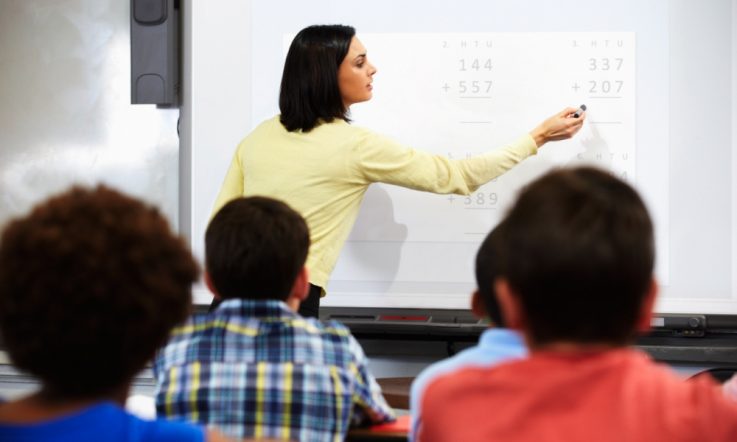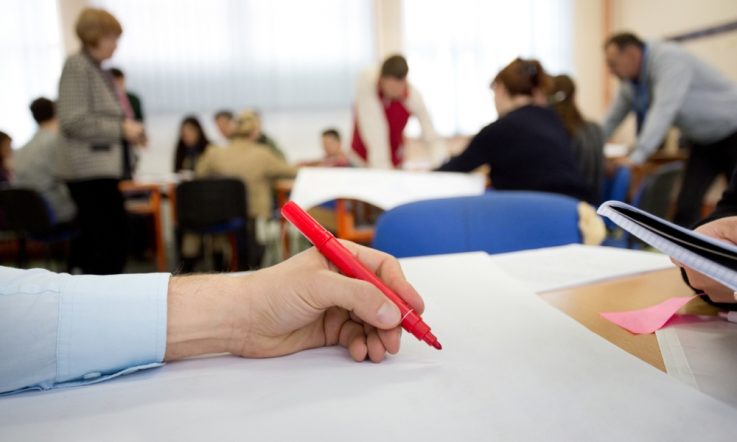This is an edited version of a case study originally published in the 2017 Excellence in Professional Practice Conference Case studies of practice book.
Camdenville Public School is a future-focused primary school in Sydney's inner west. Since 2013, the school has been exploring and implementing a range of innovative pedagogies and practices, including project-based learning (PBL) and flexible learning spaces. This change in approach arose out of school-based evaluation that identified a lack of engagement and motivation in students which was impacting on student learning outcomes and behaviour. The practices were developed and implemented over a three year period.
Overview of the context and scope of the study
The school's innovative approach to teaching and learning is evident through the incorporation of PBL, integration of technology in all aspects of learning, student-led design of flexible learning spaces, the use of social media and rich and authentic connections with the wider community.
It serves the socially and culturally diverse local suburbs of Newtown, St Peters, Enmore and Marrickville. There are approximately 260 students in the school as well as a preschool on site. Four per cent of the student population identify as Indigenous and 27 per cent have a language background other than English. The school staff has changed significantly since 2011, with an increase in the number of early career teachers. In 2016, 63 per cent of the teaching staff were in their first five years of teaching, with three of the 11 teachers in their first full year of teaching.
The school's review of the research on PBL identified key features that were evident in a range of articles, books and teacher resources, including:
- Providing students with complex tasks that require them to engage in problem solving, design, decision-making and investigation;
- Connecting the task to authentic ‘real-world' contexts and audiences, often projects culminate in the presentation of realistic products to experts or applying the products to real situations;
- Teacher facilitation rather than explicit direction;
- Explicit learning goals closely connected to curriculum outcomes; and,
- Authentic assessment.
By the end of 2015 all teachers had received professional learning in PBL. The key elements as identified by Thomas (2000) were being implemented to differing extents in classrooms across the school. In Term 1, 2016 the school conducted a review of PBL. The evidence – gathered through instructional rounds, work samples, teacher evaluation, program documents and a teacher survey – suggested teacher understandings of PBL was not consistent across the school and not all felt confident planning and implementing the approach in its entirety.
A survey of teachers demonstrated that 70 per cent felt only somewhat confident in teaching through PBL. A number of teachers said they would like support in managing the process when different groups are working on different activities, providing feedback effectively and making the most of class time to enable students to achieve project goals and produce work of a high quality.
In response, the school leadership team developed a concurrent program of professional learning in tandem with a whole school PBL project to take place in Term 3, 2016. Each week the Teacher Professional Learning (TPL) session addressed a particular aspect of PBL. Teachers engaged in reading blogs, articles and research papers about a range of areas. In addition to the TPL program the school leadership team identified the opportunity for a common PBL project for the whole school around the topic of wellbeing.
Following each TPL session a whole school planning meeting took place. At this meeting teachers shared the status of their class's PBL, discussed opportunities for collaboration between students across classes, identified curriculum outcomes that would be appropriate for the following week's learning programs and worked in stage teams to create lesson plans to address the outcomes. Explicit attention was paid to the PBL focus area for that week's professional learning and strategies were developed to trial in classrooms for the following week. This process provided a structure for teachers to discuss their learning and put it into practice with the support of colleagues.
Each TPL session commenced with an opportunity for teachers to share the strategies they had trialled, with examples of student learning, and evaluate the effectiveness of the approach, give and receive feedback and set goals for future teaching and learning. In between TPL sessions, the school leadership team gathered resources and planned sessions to address the next topic as identified by teachers.
Overview of the approach
In her synthesis of research on effective teacher professional development that has demonstrated a positive impact on student outcomes, Timperley (2008) identified 10 key principles, including: providing teachers with opportunities to drive their own professional development, allowing teachers to work collaboratively to learn and apply evidence based practices, establishing a professional learning culture that provides a safe and authentic environment for professional enquiry and ensuring school leaders take an active role in developing professional learning, and maintaining momentum within schools. Our approach addressed these key principles. All staff were involved in directing the learning throughout our TPL program and we used a range of data pre and during the TPL to design each professional learning session and set ‘in-between' tasks, which we used as discussion starters in following sessions. This professional learning process ensured teachers were provided with opportunities to learn and apply new pedagogical skills in their classrooms and evaluate and reflect on these practices with colleagues.
The Australian Institute for Teaching and School Leadership (AITSL) has produced a number of reviews of research around the key aspects of school improvement, including professional learning. Collaboration is highlighted as important for developing a shared commitment and responsibility towards student outcomes and contributes to the ongoing improvement of teaching practices and pedagogies (AITSL, 2013a).
Collaboration was at the centre of the school's approach to professional learning as teachers were engaged in gathering and evaluating evidence, sharing ideas, providing each other with feedback and planning teaching and learning programs together throughout the project. This collaboration was possible, at least in part, due to the learning culture that was established in the school. An effective learning culture in a school has a number of key features, including: engaging teachers in collaboration, using data to inform decision making and learning activities, conducting professional learning that is based on current research and identifying the impact of professional learning on staff and student outcomes from the outset (AITSL, 2013b). All of these features are well established at Camdenville and have enabled teachers to develop expectations for the quality, purpose and impact of professional learning. This generates a level of trust in the school leadership and the processes put in place for ongoing professional learning.
Instructional rounds, as defined by City, Elmore, Fiarman, and Teitel (2011), is a disciplined way for educators to work together to improve instruction and is a practice that combines three common elements of improvement: classroom observation, an improvement strategy, and a network of educators. Instructional rounds is an embedded practice at Camdenville, used to drive school change. In this instance instructional rounds provided an opportunity for teachers to act as researchers by gathering evidence, identifying patterns and evaluating what this meant for students in the school and their own practice. The rounds process ensured that the identified ‘problem of practice' of how to improve teacher understanding of PBL practices and subsequent TPL program was contextualised and directly linked to valued student outcomes. Rounds was conducted pre- and post-intervention to gather evidence and ensure that all teachers were involved in establishing clear goals and a plan for action to improve the practice of PBL across the school.
Outcomes of the approach
The post-intervention surveys and interviews showed a substantial change in teacher confidence in a variety of aspects of PBL and much greater consistency in programming and practice across the school. Pre and post teacher surveys clearly demonstrate these results. In the post-intervention survey, 100 per cent of teachers reported that they feel confident using a PBL approach – up from 30 per cent in the pre-intervention teacher survey. When looking at specific aspects of PBL, 83 per cent of teachers reported that they ensure opportunities for students to exercise voice and control – an increase of 33 per cent. Overall, teachers responded that they felt more comfortable allowing students to direct the course of PBL and involve a wide range of experts and have more opportunities to share their work with an authentic audience for feedback. All teachers felt comfortable allowing students to choose their own products or presentation strategy (up from 70 per cent), and 83 per cent said they were confident in supporting the process of PBL (up from 20 per cent). Responding to open-ended questions, teachers said they felt more confident in planning for PBL, utilising assessment processes, supporting students in managing the PBL process and connecting content taught in other lessons to the PBL product and process.
Subsequent instructional rounds identified positive changes in classroom practice. Student products were of consistently higher quality across the school and there was greater collaboration across classes due to the common topic and shared understanding of teachers. When evaluating the photos taken of the different aspects of the learning environments and the tasks in which students were engaged, teachers identified a number of significant changes, such as: students working on a greater range of products, a greater level of student self-direction and increased collaboration across different classes and year groups. There was also evidence of teachers delivering activities of increased differentiation and a greater variety of scaffolding strategies for students to use as they worked through different tasks.
Gathering a selection of teacher programs alongside student work samples provided evidence of greater detail in the planning process. Teacher programs demonstrated: much clearer steps for each part of the PBL, appropriate learning objectives, detailed success criteria, a greater level of differentiation, specific strategies to support student reflection, and planning for different possibilities. Teacher interviews reinforced this evidence.
The planning process for the subsequent Term 4 PBL highlighted the ongoing positive impact of the approach. Teachers continued to be more aware of the different aspects of PBL and demonstrate a deeper understanding of how to develop an authentic PBL project. They planned different features in greater detail, such as the entry event, ongoing feedback, assessment, opportunities to allow student voice and collaboration. In Term 1 2017 there were significant changes in the school leadership team, however teachers ensured the key processes of PBL still took place. Teachers drove the planning process, provided each other with feedback on their draft PBL plans, and ensured that the PBL met the standards established in the TPL.
Our reflections
Gathering a range of school-based evidence, such as lesson observations, coaching records, teacher reflections, teacher programs, student reflections and products, prior to implementing the professional learning enabled the leadership team to plan learning that would meet the needs of the teachers and impact practice across the school. While this evidence gave a good starting point and overview, it was also important to respond to feedback and issues that arose each week. This ensured the changing and diverse needs identified by the whole staff were met and that teachers could authentically implement what they learnt in real-time.
The opportunities for reflection, evaluation and goal-setting were what drove this project and empowered teachers to take ownership of the learning process. This was further enhanced by the culture of trust and collaboration that existed at the school prior to the intervention. Without a high level of trust and a belief in the value of collaboration we feel this sort of project would be very difficult to run effectively and would likely have a reduced impact across the school.
This is an edited version of a case study originally published in the 2017 Excellence in Professional Practice Conference Case studies of practice book.
References and further reading
Australian Institute for Teaching and School Leadership (2014). Global Trends in Professional Learning and Performance Development Report. https://www.aitsl.edu.au/tools-resources/resource/global-trends-in-professional-learning-and-performance-development
Australian Institute for Teaching and School Leadership (2013a). The Essential Guide to Professional Learning: Collaboration. https://www.aitsl.edu.au/tools-resources/resource/the-essential-guide-to-professional-learning-collaboration
Australian Institute for Teaching and School Leadership (2013b). The Essential Guide to Professional Learning: Leading Culture. https://www.aitsl.edu.au/tools-resources/resource/the-essential-guide-to-professional-learning-leading-culture
City, E.A., Elmore, R.F., Fiarman, S.E. & Teitel, L. (2009). Instructional Rounds in Education. Boston, MA: Harvard Education Press.
NSW Department of Education and Communities, Centre for Education Statistics and Evaluation. (2014). Elements of Effective Professional Development. Retrieved from http://gtil.cese.nsw.gov.au/images/pdf/PDLitRev.pdf
Thomas, J.W. (2000). A Review of Research on Project-Based Learning. Retrieved from http://www.bie.org/images/uploads/general/9d06758fd346969cb63653d00dca55c0.pdf
Timperley, H. (2008). Teacher Professional Learning and Development. Brussels, Belgium: International Academy of Education.
As a school leader: What are the current professional learning needs of your teachers? How do you know? How do you ensure professional learning programs meet these needs? Do you encourage and provide opportunities for feedback from staff?



